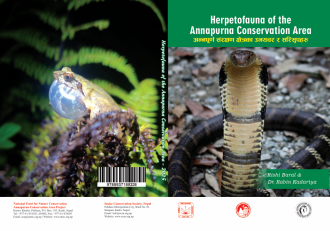Herpetofauna of the Annapurna Conservation Area
This book is based on research and surveys of amphibians and reptiles conducted by NTNC-ACAP and its Unit Conservation Offices. Many records are derived from opportunistic observations made during routine forest patrolling and regular conservation program activities. In addition, literature records, photographs, and rescue data are incorporated as references. The report titled Biodiversity Conservation Data, prepared by the Biodiversity Conservation Data Project team and submitted to the King Mahendra Trust for Nature Conservation (KMTNC) in July 1994, serves as a primary reference.
A total of 91 species of herpetofauna are recorded in the Annapurna Conservation Area (ACA), including 61 species of reptiles and 30 species of amphibians. These belong to 2 orders and 15 families. Among the most species-rich groups are the amphibian family Dicroglossidae with 13 species, and the reptile family Colubridae with 25 species. Of Nepal’s three nationally prioritized protected herpetofauna species, one is found in ACA.
Furthermore, five species found in ACA are listed in the CITES appendices (Appendix I = 1 species, Appendix II = 4 species), including one amphibian and four reptiles. Two species included in previous checklists are excluded from this book due to inconsistencies in scientific naming and distribution records. Of the 61 reptile species, 23 species are lizards, skinks, and geckos, and 38 species are snakes. Notably, four species discovered from the ACA are new records for Nepal: Boulenger's High Altitude Toad (Scutiger boulengeri), Mustang Frog / Rostand's Paha Frog (Nanorana rostandi), Annapurna Bent-toed Gecko (Cyrtodactylus annapurnaensis), Himalayan Pit Viper (Protobothrops himalayanus) In total, eight species of herpetofauna recorded in ACA are endemic to Nepal, comprising four amphibians and four reptiles. At the global level, six species found in ACA are listed as Vulnerable (VU), including Duttaphrynus microtympanum, Scutiger nepalensis, Nanorana rostandi, Python bivittatus, and Ophiophagus hannah. In addition, Nanorana ercepeae is listed as Near Threatened (NT), while Liopeltis rappi and Boiga multifasciata are classified as Data Deficient (DD).
This book presents an updated checklist of herpetofauna in the Annapurna Conservation Area, compiled from diverse data sources. Further research and systematic surveys are likely to reveal additional species from this biologically rich region.

